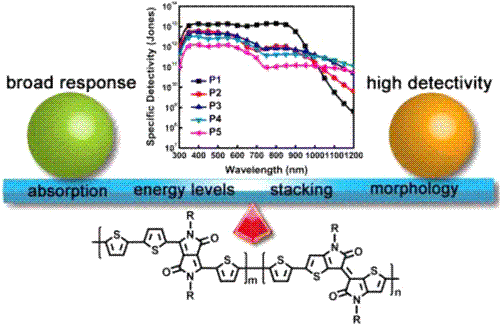- [2015][Macromolecules, 2015, 48 (12), 3941–3948]Optimization of Broad-Response and High-Detectivity Polymer Photodetectors by Bandgap Engineering of Weak Donor–Strong Acceptor Polymers
- 来源:乔文强教授个人网站 2015-07-16
A series of weak donor–strong acceptor polymers containing two different electron-deficient units (diketopyrrolopyrrole and thienoisoindigo) are synthesized and used in broad-response and high-detectivity polymer photodetectors. By adjusting the composition ratio of the two acceptors, the absorption spectra, energy levels, molecular stacking, and film morphology are affected, which in turn influence the photodetector performance. With increased thienoisoindigo component, the HOMO energy levels shift from ?5.41 to ?4.76 eV, and the LUMO energy levels are nearly unchanged, corresponding to reduced bandgaps and red-shifted absorption spectra. 1,8-Diiodooctane additive shows greatly impact on the film morphology, which affects the photodetector performance significantly. Going from P1 to P5, the detectivity decreases, but the response range increases. The photodetector based on P4 exhibits detectivity of greater than 1011 Jones in a broad spectral region of 300–1200 nm, which is really promising for UV–vis–NIR light detection.

- [来源:中国聚合物网]
- 了解更多请进入: 乔文强教授个人网站
- · [2015][RSC Adv., 2015,5, 100736-100742]Broad-spectrum chemiluminescence covering a 400–1400 nm spectral region and its use as a white-near infrared light source for imaging
- · [2015][J. Phys. Chem. C, 2015, 119 (45), 25243–25251]End-Group Engineering of Low-Bandgap Compounds for High-Detectivity Solution-Processed Small-Molecule Photodetectors
- · [2013][Polymer, 2013, 54: 5543–5552] Synthesis and Characterizations of Conjugated Copolymers Containing Benzo[f]isoindole–1,3–dione and Diketopyrrolopyrroleunits
- · [2011][Chem. Commun., 2011,47: 4276-4278]Donor–acceptor Type Silole Compounds with Aggregation–Induced Deep–red Emission Enhancement: Synthesis and Application for Significant Intensification of Near–infrared Photoluminescence